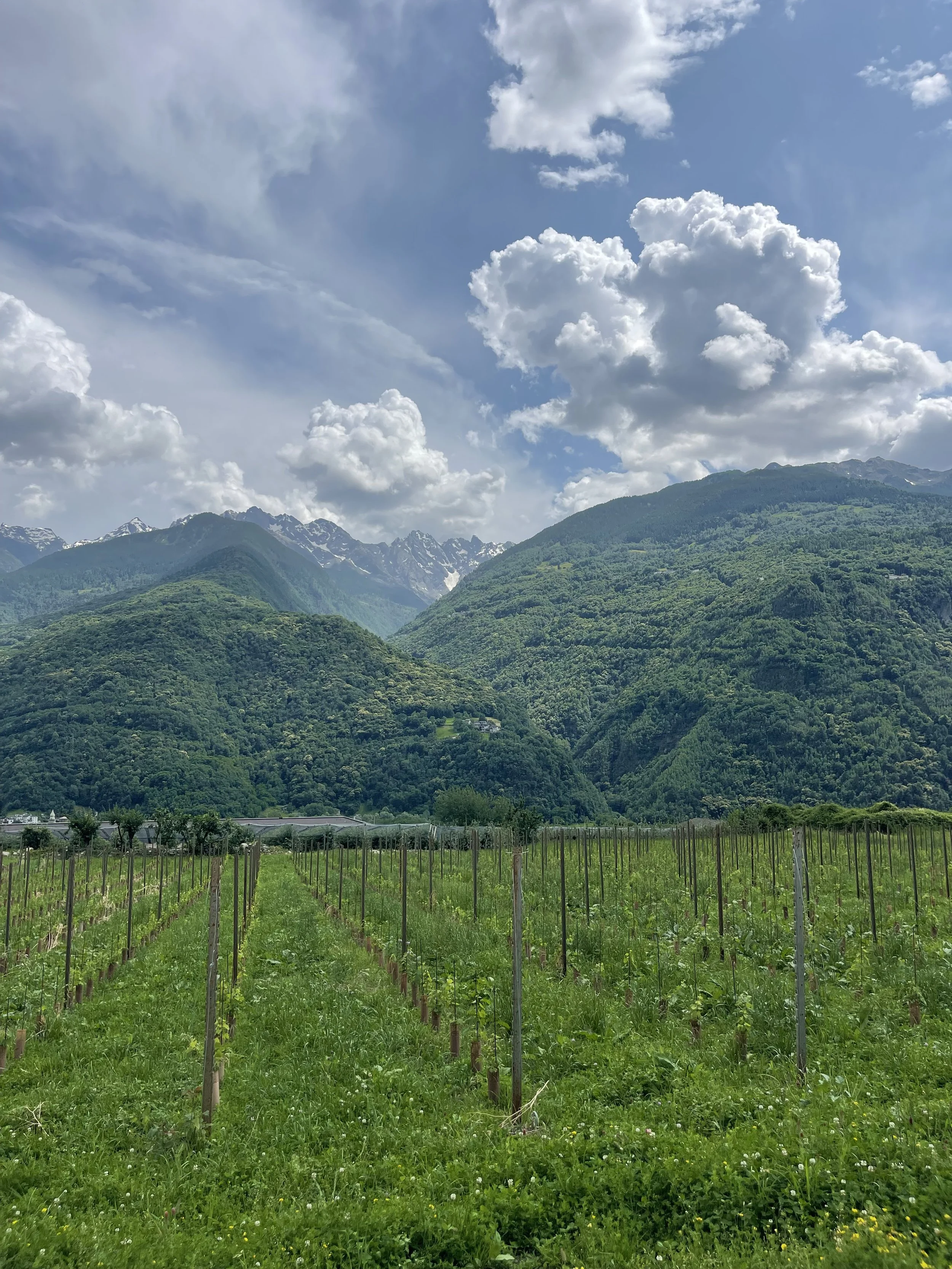Valtellina Wines: Discovering Alpine Nebbiolo in Lombardy’s Heroic Vineyards
/by: Alexa
Welcome to Valtellina, a unique and historic wine region located in the heart of Lombardy, in the province of Sondrio. Tucked between towering Alpine mountain ranges and carved by the Adda River, Valtellina is one of the most spectacular—and underrated—wine regions in Italy.
This long, narrow valley, just northeast of Lake Como, is the proud home of Chiavennasca, the local name for Nebbiolo, grown on ancient terraced vineyards clinging to steep mountain slopes. The result? Elegant, mineral-driven wines that truly reflect their alpine terroir.
The Terroir of Valtellina: Mountains, Sun, and Stone
Valtellina is defined by its geography. Nestled between the Rhaetian Alps to the north and the Orobie Prealps to the south, the region enjoys natural protection and a unique microclimate.
A cool breeze known as the “beva” blows in from Lake Como, helping to ventilate the vineyards and reduce disease pressure. The vines are typically planted on south-facing slopes between 300 and 800 meters above sea level, where they benefit from over 1,900 hours of sunshine per year.
The diurnal temperature variation—the difference between warm days and cool nights—enhances the aromatic complexity and freshness of the grapes, especially crucial during the ripening period.
Terraced Vineyards and Ancient History
One of the most distinctive features of Valtellina is its dramatic terraced vineyards, built into the steep Alpine slopes with dry-stone walls (about 25,000 meters of walls. You can go from Sondrio to Stockholm). This ancient system of farming is part of what makes Valtellina a region of “heroic viticulture”—where nearly all vineyard work must be done by hand.
Wine has been made here since classical antiquity. The Roman poet Virgil praised Valtellina’s grapes in the Georgics, and Pliny the Elder admired the elegance of its wines. The practice of terracing these rugged hillsides likely began during the Roman Empire.
In the 1400s, even Leonardo da Vinci mentioned Valtellina, noting its powerful wines and dramatic mountain landscape.
The Grape: Nebbiolo (Chiavennasca)
While Nebbiolo is best known for its role in Barolo and Barbaresco, it takes on a distinct character in Valtellina, where it’s called Chiavennasca. This name, derived from the local dialect ciuvinasca, refers to “the grape best suited for winemaking.”
Today, over 90% of Valtellina’s vineyards are planted to Nebbiolo. The remaining 10% consists of native varieties like Rossola Nera, Pignola Valtellinese, and Brugnola.
Soils of Valtellina: Rock, Mineral, and Depth
The soils of Valtellina are of glacial, morainic, and alluvial origin, packed with minerals and rocks (we are talking Iron, Granite, Schist) that force the vines to push their roots deep into the mountain. The poor, shallow topsoil challenges the vines, resulting in grapes with intense concentration and structure.
This rocky, well-draining soil is essential to the fine tannins and mineral backbone that define Valtellina wines.
The Wines of Valtellina
Valtellina Superiore DOCG
Recognized as a DOCG in 1998, this wine must contain at least 90% Nebbiolo. It’s produced from grapes grown in the best, sunniest vineyard sites. A Riserva version is also permitted.
Aging: Minimum 24 months, including 12 months in wood
Riserva: Minimum 36 months, with 12 months in wood
Five Subzones: Maroggia, Sassella, Grumello, Inferno, Valgella
Each subzone brings its own nuance, from the structured wines of Inferno to the more delicate styles of Valgella.
Sforzato di Valtellina DOCG (Sfursat)
Granted DOCG status in 2003, Sforzato is Italy’s first dry red passito wine to achieve this level. Made from at least 90% Nebbiolo, the grapes are harvested early and dried in well-ventilated rooms (fruttai) before vinification.
Aging: Minimum 20 months, including 12 months in wood
Style: Rich, powerful, velvety, and age-worthy
This wine combines the elegance of Nebbiolo with the richness and depth of an appassimento-style wine.
Rosso di Valtellina DOC
This is the entry-level Nebbiolo from the region often considered the “younger sibling” of the two DOCG wines. Offering a fresher, more approachable expression of the grape.
Vineyards: Spread across hillside and foothill zones
Style: Lighter, juicy, and food-friendly, perfect for everyday enjoyment
Rosso di Valtellina is often the first taste wine lovers have of the region and a great introduction to its unique alpine Nebbiolo style.
Why Valtellina Deserves a Place on Every Wine Lover’s Map
Though less known internationally than its Piedmontese cousins, Valtellina’s Nebbiolo wines are some of Italy’s most elegant and expressive. The combination of altitude, mountain air, mineral-rich soils, and centuries-old tradition results in a style of wine that is distinctly alpine—refined, aromatic, and full of soul.
Whether you’re a Nebbiolo devotee or just discovering this fascinating grape, Valtellina offers a wine experience unlike any other.
Want to learn more about the Nebbiolo grape and visit this region with a first hand wine pro?! Join me on my next Nebbiolo Madness tour.
You can find out more about this tour here.




